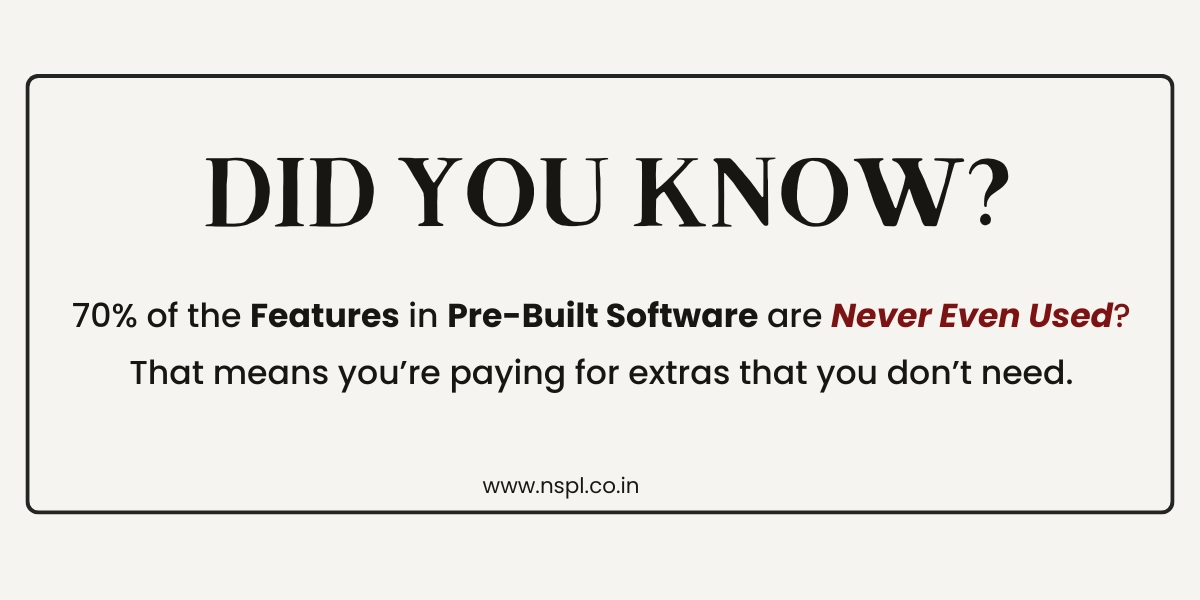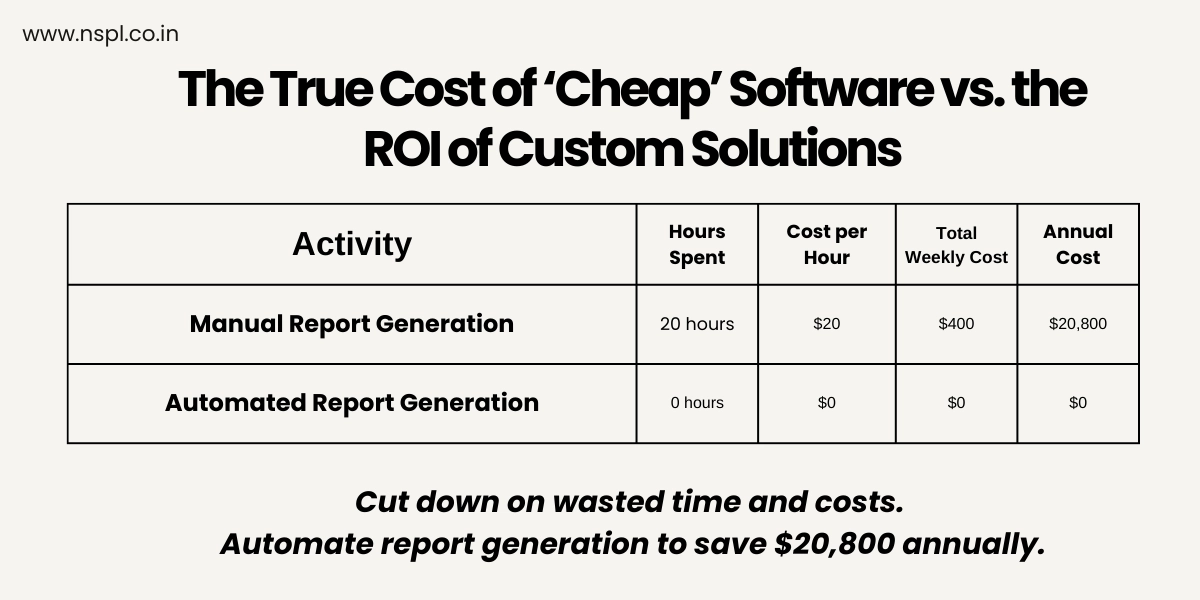Table of contents
Why Investing in Custom Software Saves You Money in the Long Run
It’s 6 PM. Your team is still at the office, manually updating spreadsheets because your current software can’t talk to your inventory system. Your customer service inbox is flooded with complaints about delayed orders. And you just got another invoice from that generic project management tool you barely use—$300 down the drain, again.
Sound familiar?
You’re not alone.
Every day, businesses like yours waste thousands of dollars and hundreds of hours trying to force-fit generic software into unique workflows. The frustration, inefficiency, and spiralling costs are not just annoying—they’re a threat to your competitive edge.
But what if you could replace that chaos with a tailored solution designed to work seamlessly with your operations? What if you could eliminate the constant busywork and redirect your focus toward growing your business? That’s the power of custom software.
In this blog, we’ll dive deep into why investing in custom software isn’t just another expense—it’s a strategic move that pays for itself in the long run. We’ll explore the hidden money traps of generic software, illustrate the tangible benefits of a custom solution through real-world examples, and show you exactly how the right technology can transform your business’s bottom line.

The Hidden Money Trap of Generic Software
1. The Illusion of “One-Size-Fits-All”
Generic software is designed to appeal to a broad market. Think of it like buying a Swiss Army knife when all you need is a high-quality screwdriver. Sure, it has lots of features, but many of them sit unused while you pay for unnecessary bells and whistles. This is the first trap: You pay for features you don’t need.
- Subscription Overload: Many businesses subscribe to multiple tools hoping each will solve a specific problem. Instead, you end up with overlapping functionalities that just add to your monthly costs.
- Patchwork Systems: When one tool doesn’t talk to another, your employees resort to manual workarounds—copying and pasting data between systems, double-checking entries, and ultimately, wasting hours every week.
2. The Hidden Costs of Workarounds
Let’s be honest: manual processes aren’t just inefficient—they’re expensive. Every time an employee spends an extra minute on a task that could be automated, your business loses money. These workarounds create a ripple effect:
- Time Lost in Translation: Employees are experts in what they do, not in troubleshooting software mismatches. Hours that could be spent on strategic work are wasted on repetitive tasks.
- Error-Prone Processes: Manual data entry invites mistakes. Each error can result in costly billing mistakes, shipping errors, or miscommunication with your customers.
3. The Scaling Nightmare
As your business grows, so do your software needs. Generic solutions often come with hidden scaling costs:
- User Additions: Need to add more users? Expect steep fees that weren’t part of your initial plan.
- Integration Hurdles: Integrating new tools or systems often means waiting for vendor updates or paying extra for compatibility features.
- Endless Upgrades: Vendors often push upgrades that cost more but deliver diminishing returns. Your investment in generic software keeps rising without a corresponding boost in efficiency.
In essence, generic software is like a leaky bucket. No matter how much you pour into it—time, money, and energy—you’ll always lose more than you save.
How Custom Software Becomes Your Business’s Best Friend
Imagine a solution built exclusively for your business—a tool that knows your processes, understands your challenges, and is designed to eliminate inefficiencies. That’s custom software.
Meet Sarah: The FreshBakes Transformation
Let’s illustrate with a story. Meet Sarah, the owner of FreshBakes, a small bakery that was once drowning in operational chaos.
Sarah’s Problem
Before turning to custom software, Sarah’s team juggled three different apps to manage orders, inventory, and customer loyalty. This fragmented approach led to:
- Lost Orders: With orders being managed across separate systems, mistakes were frequent, leading to lost sales.
- Inventory Inaccuracies: Mismatches between what was recorded and what was available meant unexpected flour runs at 3 AM.
- Customer Frustrations: When orders were delayed or incorrect, customer complaints piled up.
All of these issues cost FreshBakes dearly—Sarah’s business was hemorrhaging money. She was paying over $12,000 a year in subscriptions alone and losing more than 20 hours each week fixing avoidable mistakes.
Sarah’s Custom Software Solution
Sarah decided to invest in a custom solution tailored to her bakery’s specific needs. The new system was designed to integrate orders, manage inventory, and even personalize customer rewards. Here’s how it transformed her business:
- Automated Orders: With a system that directly routed online orders to the kitchen, there were no more missed cupcake orders or delays.
- Synced Inventory: Inventory was updated in real-time as orders were placed, eliminating the need for those frantic, off-hour ingredient checks.
- Personalized Loyalty Rewards: The software tracked customer preferences and sent personalized discounts and alerts—ensuring customers felt valued and were more likely to return.
The Results
The outcome was dramatic:
- Cost Savings: Fresh Bakes saved around $8,000 per year by cutting out redundant software subscriptions.
- Error Reduction: Mistakes dropped by 70%, leading to smoother operations and happier customers.
- Enhanced Revenue: With customers receiving a VIP experience, sales increased by 30% as repeat business grew.
Sarah’s story isn’t an anomaly. It’s a powerful example of how a tailored solution can fix inefficiencies, streamline operations, and ultimately, save money.
How Custom Software Pays for Itself

Custom software is more than just code—it’s like hiring a superstar employee who works tirelessly, makes zero mistakes, and continuously saves your business money. Let’s break down the math behind these savings.
1. Slash Repetitive Costs
The Impact:
By replacing three separate subscriptions with one tailored system, you can save up to $4,000 annually. This is money you can reinvest in growth initiatives or use to improve your profit margins.
2. Eliminate Costly Errors
The Custom Fix:
Custom software automates billing processes, ensuring accuracy and reducing errors significantly. When your invoicing is correct the first time, you not only avoid refunding money to customers but also build trust and improve operational efficiency.
3. Free Up Time to Grow
The Custom Fix:
By automating the process of creating and sending bills, for example, businesses can dramatically reduce costly manual errors. But how do you find the right solution tailored to your specific needs? That’s where Nest Software Private Ltd. comes in.
At Nest Software Private Ltd., we specialize in creating custom software development solutions that seamlessly integrates with your unique business operations. From automating key processes to eliminating inefficiencies, we design systems that save you time, reduce costs, and boost productivity. Our team is here to help you transform your operations, just like we did for FreshBakes.
Overcoming Common Concerns
We understand that investing in custom software can feel intimidating. Change is always accompanied by uncertainty, but many of the common worries can be easily addressed:
“I’m Not Tech-Savvy!”
Many business owners fear that implementing new software will require them to become experts in technology. The truth is, you don’t have to. With custom software, you partner with developers who listen to your needs and translate them into simple, user-friendly solutions. The focus is on solving your problems, not on complex technical jargon.
What If It Doesn’t Work?
The best way to overcome this fear is to start small. Instead of overhauling your entire system at once, begin by automating one key process—such as invoicing or order management. Once you see the immediate benefits and cost savings in 3-6 months, you can expand gradually. This phased approach minimizes risk and allows you to adapt as needed.
I Can’t Afford It Right Now!
It’s common to worry about the initial cost of custom software. However, many developers offer phased payment plans that make the investment more manageable. When you consider the potential savings—whether it’s cutting out multiple subscriptions, reducing errors, or freeing up valuable time—the return on investment can often cover the costs within the first year. In other words, custom software pays for itself.
Why You Can’t Afford to Wait
In today’s fast-paced business world, time is of the essence. Every day you delay in addressing inefficiencies is a day your competitors are gaining ground. Think about it:
- Lost Opportunities: While you’re stuck with generic software that doesn’t fit your needs, your competitors are leveraging technology to streamline operations, improve customer experiences, and drive revenue.
- Missed Savings: Each month, you’re wasting money on unnecessary subscriptions and error corrections. These lost dollars could be reinvested in growth initiatives or improving your bottom line.
- Employee Frustration: Your team is demoralized by inefficient processes. Frustrated employees are less productive and more likely to leave, costing you even more in recruitment and training.
Investing in custom software is not just about saving money—it’s about staying relevant in a competitive market. The longer you wait, the more you risk falling behind, losing customers, and missing out on the significant efficiencies that custom software can bring.
A Roadmap to Your Custom Software Journey
Step 1: Identify Your Biggest Pain Points
Take a hard look at your current operations. Where are the bottlenecks? Which processes are most prone to errors? Often, the biggest issues are hidden in plain sight—like the hours spent manually updating spreadsheets or the cost of correcting billing mistakes. Identifying these pain points is the first step toward finding a solution that truly works for you.
Step 2: Calculate the True Cost of Generic Software
Document all your current software expenses—subscriptions, add-on fees, integration costs, and the hidden costs of manual workarounds. Compare these figures with the potential savings that a custom solution could provide. Often, you’ll find that the money spent on generic tools far outweighs the investment in a tailored solution.
Step 3: Consult with a Trusted Software Partner
You don’t have to navigate this journey alone. Consult with experts who specialize in providing custom software development solutions. A good development partner will listen to your challenges, analyze your workflow, and propose a system that addresses your unique needs. Many firms even offer a free 30-minute consultation to help you identify the #1 process wasting your money and to build a realistic plan to fix it.
Step 4: Start Small and Scale Gradually
There’s no need to transform your entire business overnight. Begin with one feature—such as automating your invoicing process—and once you see the immediate benefits, gradually expand the system’s capabilities. This approach not only minimizes risk but also provides a clear demonstration of how custom software can save you money.
Step 5: Measure and Reinvest the Savings
As your new system takes over the repetitive tasks and streamlines your operations, track the cost savings and productivity gains. Reinvest these savings into further optimizing your processes or expanding your business. Over time, you’ll see that every dollar saved is a dollar that can be used to drive growth.
Conclusion: The Choice Is Yours
Imagine a year from now. If you continue using generic software, you’ll still be overpaying for tools that don’t fit, your team will remain bogged down in busywork, and competitors will keep stealing your customers. But if you invest in custom software, the results can be transformative:
- Thousands of Dollars Saved: With reduced subscription fees, minimized errors, and streamlined operations, you’ll see significant cost savings.
- Enhanced Productivity: Your team will be free to focus on growth, innovation, and customer satisfaction.
- Competitive Advantage: By leveraging technology that’s tailored to your business, you’ll be able to respond more quickly to market changes and customer needs, making you the preferred choice over your competitors.
The choice is clear. While the initial investment in custom software might seem daunting, the long-term benefits far outweigh the costs. It’s not just a purchase—it’s an investment in a future where your business operates more efficiently, saves money, and scales gracefully.
Don’t let inefficiencies hold you back. Every day you delay, you’re losing money and falling further behind your competitors. Embrace the change, invest in a solution that grows with your business, and watch as your bottom line transforms.
